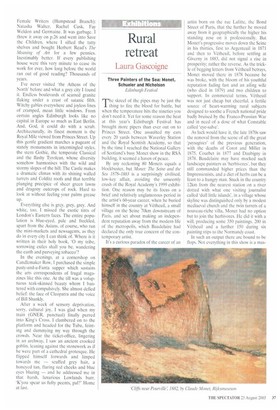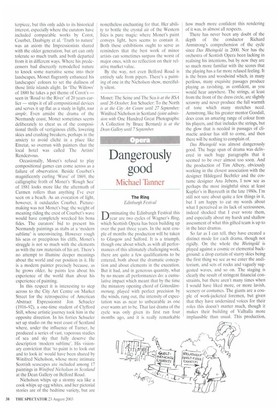Rural retreat
Laura Gascoigne
Three Painters of the Sea: Monet, Schueler and Nicholson Edinburgh Festival
The skreel of the pipes may be just the thing to fire the blood for battle, but when the temperature hits the nineties you don't need it. Yet for some reason the heat at this year's Edinburgh Festival has brought more pipers than ever out on to Princes Street. One assaulted my ears every 20 yards between Waverley Station and the Royal Scottish Academy, so that by the time I reached the National Gallery of Scotland's busy Monet show in the RSA building, it seemed a haven of peace.
By any reckoning 80 Monets equals a blockbuster, but Monet: The Seine and the Sea 1878-1883 is a surprisingly civilised, low-key affair, avoiding the unseemly crush of the Royal Academy's 1999 exhibition. One reason may be its focus on a brief and relatively unglamorous period in the artist's 60-year career, when he buried himself in the country at Vetheuil, a small village on the Seine 70km downstream of Paris, and set about making an independent reputation away' from the modern life of the metropolis, which Baudelaire had declared the only true concern of the contemporary artist.
It's a curious paradox of the career of an
artist born on the rue Lafitte, the Bond Street of Paris, that the further he moved away from it geographically the higher his standing rose on it professionally. But Monet's progressive moves down the Seine in his thirties, first to Argenteuil in 1871 and then to Vetheuil, before settling at Giverny in 1883, did not signal a rise in prosperity; rather the reverse. As the trickle of begging letters from Vetheuil betrays, Monet moved there in 1878 because he was broke, with the bloom of his youthful reputation fading fast and an ailing wife (who died in 1879) and two children to support. In commercial terms, Vetheuil was not just cheap but cheerful, a fertile source of heart-warming rural subjects designed to soothe a French national pride badly bruised by the Franco-Prussian War and in need of a dose of what Constable called 'eye-salve'.
As luck would have it, the late 1870s saw the removal from the scene of all the great 'paysagistes' of the previous generation, with the deaths of Corot and Millet in 1875, Courbet in 1877 and Daubigny in 1878. Baudelaire may have mocked such landscape painters as 'herbivores', but they still commanded higher prices than the Impressionists, and a diet of herbs can be a feast to a hungry man. Stuck in the country 12km from the nearest station on a river dotted with what one visiting journalist called 'dull little islands', in a village whose skyline was distinguished only by a modest mediaeval church and the twin turrets of a nouveau-riche villa, Monet had no option but to join the herbivores. He did it with a will, producing some 350 paintings, 200 in Vetheuil and a further 150 during six painting trips to the Normandy coast.
In such an output there are bound to be flops. Not everything in this show is a mas
terpiece. but this only adds to its historical interest, especially where the curators have included comparable works by Corot, Courbet, Daubigny et al, 'Truth to nature' was an axiom the Impressionists shared with the older generation, but art can only tolerate so much truth, and both departed from it in different ways. Where his predecessors had discreetly remodelled nature to knock some narrative sense into their landscapes, Monet flagrantly enhanced his landscapes' colours to set the dullness of those little islands alight. In 'The Willows' of 1880 he takes a pet theme of Corot's seen in 'Road to the River' of 20 years earlier — strips it of all compositional devices and serves it up flat as a study in light, tour simple. Even amidst the drama of the Normandy coast, Monet sometimes seems deliberately to cheat us of the compositional thrills of vertiginous cliffs, lowering skies and crashing breakers, perhaps in the anxiety to avoid cliché in a place like Etretat, SO overrun with painters that the local hotel was called The Artists' Rendezvous.
Occasionally, Monet's refusal to play compositional games can come across as a failure of observation. Beside Courbet's magnificently curling 'Wave' of 1869, the calligraphic froth of Monet's 'Rough Sea' of 1881 looks more like the aftermath of Carmen rollers than anything I've ever seen on a beach. As an evocation of light, however, it outdazzles Courbet. Picturemaking was not Monet's bag: the weight of meaning riding the crest of Courbet's wave would have completely wrecked his bona fides. The curators' bid to present his Normandy paintings as stabs at a 'modern sublime' is unconvincing. However rough his seas or precipitous his cliffs, Monet's struggle is not so much with the elements as with the raw materials of his art. There's no attempt to illumine deeper meanings about the world and our position in it. He is a modern painter precisely because, as he grows older, he paints less about his experience of the world than about his experience of painting.
In this respect it is interesting to step across to the City Art Centre on Market Street for the retrospective of American Abstract Expressionist Jon Schueler (1916-92), a one-time student of Clyfford Still, whose artistic journey took him in the opposite direction. In his forties Schueler set up studio on the west coast of Scotland where, under the influence of Turner, he produced a series of vast, vaporous studies of sea and sky that fully deserve the description 'modern sublime'. His visionary conviction that 'to paint is to look out and to look in' would have been shared by Winifred Nicholson, whose more intimate Scottish seascapes are included among 17 paintings in Winifred Nicholson in Scotland at the Dean Gallery on Belford Road.
Nicholson whips up a stormy sea like a cook whips up egg whites, and her pictorial stories are of the bedtime variety, but are nonetheless enchanting for that. Her ability to bottle the crystal air of the Western Isles is pure magic: where Monet's paint conveys light, hers seems to contain it. Both these exhibitions ought to serve as reminders that the best work of minor artists can sometimes surpass the worst of major ones, with no reflection on their relative market value.
By the way, not even Belford Road is entirely safe from pipers. There's a painting of one in the Nicholson show, mercifully silent.
Monet: The Seine and The Sea is at the RSA until 26 October: Jon Schueler: To the North is at the City Art Centre until 27 September; Winifred Nicholson in Scotland (joint admission with One Hundred Great Photographs: A Collection by Bruce Bernard) is at the Dean Gallo), until 7 September.



























































 Previous page
Previous page